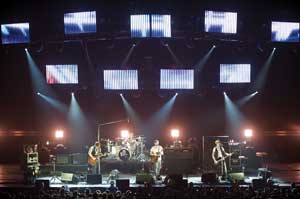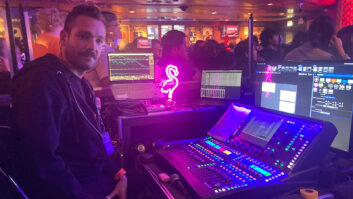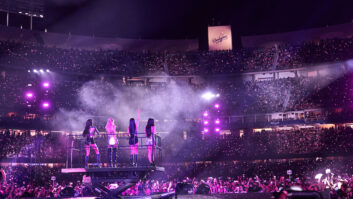
Kings of Leon performing
Photos: Steve Jennings
Tennessee-bred Kings of Leon enjoyed immediate popularity in the UK with their 2003 debut, Youth & Young Manhood. Since then, the band has released three more albums and is currently touring under their latest, Only by the Night. With each outing, the foursome continues to garner additional fans. Starting out with mid-sized venues and adding more dates in larger arenas, the tour also finds the rock quartet headlining European festivals and performance slots at this year’s Lollapalooza event.
Mix caught up with the band’s longtime front-of-house engineer, Brent Rawlings, and monitor engineer Wayne “Rabbit” Sargeant at San Francisco’s Bill Graham Civic Auditorium. Both engineers are quick to say that their mixes are straight-ahead rock ‘n’ roll — no fancy effects, just some basic EQ and compression when needed, and mixing is done on the fly.
Rawlings works on a Midas XL4, which he calls the “mother ship.” “Back before I could carry a desk, I had to use desk du jour,” Rawlings says of choosing the XL4. “I quickly learned that the Midas had a warmer tone than [other boards] — the XL4 even more so and I look forward to trying the XL8 digital desk.

Kings of Leon FOH engineer Brent Rawlings
“I use and know digital out of necessity,” he continues. “I don’t think I could survive in this industry without knowing digital. When given the choice, I prefer analog: I’m faster on it and it sounds better.” That said, Rawlings is using very little outboard in his mix: dbx 160s for compression, Summit tube comps, Waves Maxx Bass comp and a BSS 901 on Caleb Followill’s lead vocals. “I use most all compression on the subgroup and stereo master,” Rawlings adds. “This lets me push up into the compression with just the punch of a fader instead of making threshold adjustments. I’ve worked with [the band] since they started, so I’ve been able to learn and change along the way. I didn’t use compression before, but now I embrace it. I’m compressing my compressors!
“I’m trying to do a straightforward rock ‘n’ roll mix,” he continues. “I’d like you to feel the kick, be able to distinguish the vocal and be able to rock out to all three guitars — all this without being painful: I try to carve out as much middle as I can get away with.”
Monitor World
Monitor engineer Sargeant also carries little in the way of outboard processing. In addition to his “old-faithful” Midas H3000 board, he relies on a Crane Song SCT-8 for vocals, “mainly for a little protection and pure second-order harmonics,” Sargeant explains. “I also have two Empirical Labs Distressors over Nathan [Followill, drummer], which does a similar job to the Crane Song. I also use a Lexicon PCM80 for Caleb’s vocal reverbs, a TC Electronic M2000 for Nathan’s snare and vocal reverb, and a Yamaha SPX-990 for Matthew [Followill’s, lead guitarist] vocal reverb.”

Kings of Leon monitor engineer Wayne Sargeant
The band, which also includes bassist Jared Followill, uses a combination of wireless in-ears (Sennheiser G2 systems with an AC3000 combiner and a helical antenna), hard-wired in-ears powered by two Stewart P100 amps, four pairs of d&b M2 wedges and four d&b Q-subs for drums. “Caleb uses in-ears, but lately tends to only use one ear in as he likes to vibe off the audience,” Sargeant says. “So now I mix a balance of kick drum in his guitar and vocals into his wedge.
“Each bandmember has quite different mixes because of the combination of ears and wedges and all are very demanding,” Sargeant continues. “Because of this, I incorporate a Tech Talk system to accommodate the drum tech [Darin Ledford] and two guitar techs [Christopher “Nacho” Followill and Jay Schleusener] into my ear mix. This helps to ensure that all bandmembers are covered and results in a smooth-running show. Each tech has an ear pack and a talk mic, so we can talk during the show without disturbing the band. We can confer on all sound and monitor issues onstage, which is a great help at times.”
A d&b Hang
Eighth Day Sound provided a d&b J Series P.A., which includes subs on the floor and in the air running in cardioid mode (rear-bass rejection). “This is to clean up the stage,” Rawlings explains. The high-mid cabs are up to 12 a side, depending on venue size. The number of side hangs also fluctuates based on where the band is playing, with Rawlings citing between eight to 10 per side. The side hangs have reverse stereo image so Rawlings can pan instruments hard and clear up the center for vocals. The rear hangs are usually a few mono small boxes.
“Lots of stuff in the air means lots of time alignment,” Rawlings says. “I’m still in the learning phase of time alignment and tuning. I rely on the system tech heavily. I’ve learned a lot in the past few years. I help EQ a lot in voicing the P.A. to be able to turn up the center vocal mic — the hottest mic onstage in most rock scenarios.” System tuning is via Smaart and Lake EQ.
Record-Enable
The band is also multitracking each gig with a MOTU rig comprising a 24i and a 2408mk3 with a Mac front end. The FOH board’s XL direct outs have their own attenuation knobs. “A 40-channel multipin disconnect lives in the console,” Rawlings explains of his signal chain for recording. “It goes straight from the console mic preamps to the MOTU — just plug and go daily.”
Sarah Benzuly is Mix and EM‘s managing editor.
MIC SELECTIONS
Nathan Followill’s drum kit is miked with a Shure 91 and 52 (kick), 57 (snare bottom), KSM 32 (snare top) and Sennheiser 904 (toms). “My favorite and abnormal is a stereo RØDE NT4 for drum overhead,” Rawlings says. “Due to perfect phase from its fixed X/Y pattern, it’s allowed me to turn up the overhead, which, in this case, is more of a full kit sound.” Both kick mics, bottom snare, second snare are toms are gated with Drawmer 201s.
Guitars are miked with both a Sennheiser 604 and an Audio-Technica AT4050. Bass goes direct into an Avalon U5, while vocals are Sennheiser 935 — “nothing crazy,” Rawlings says.






